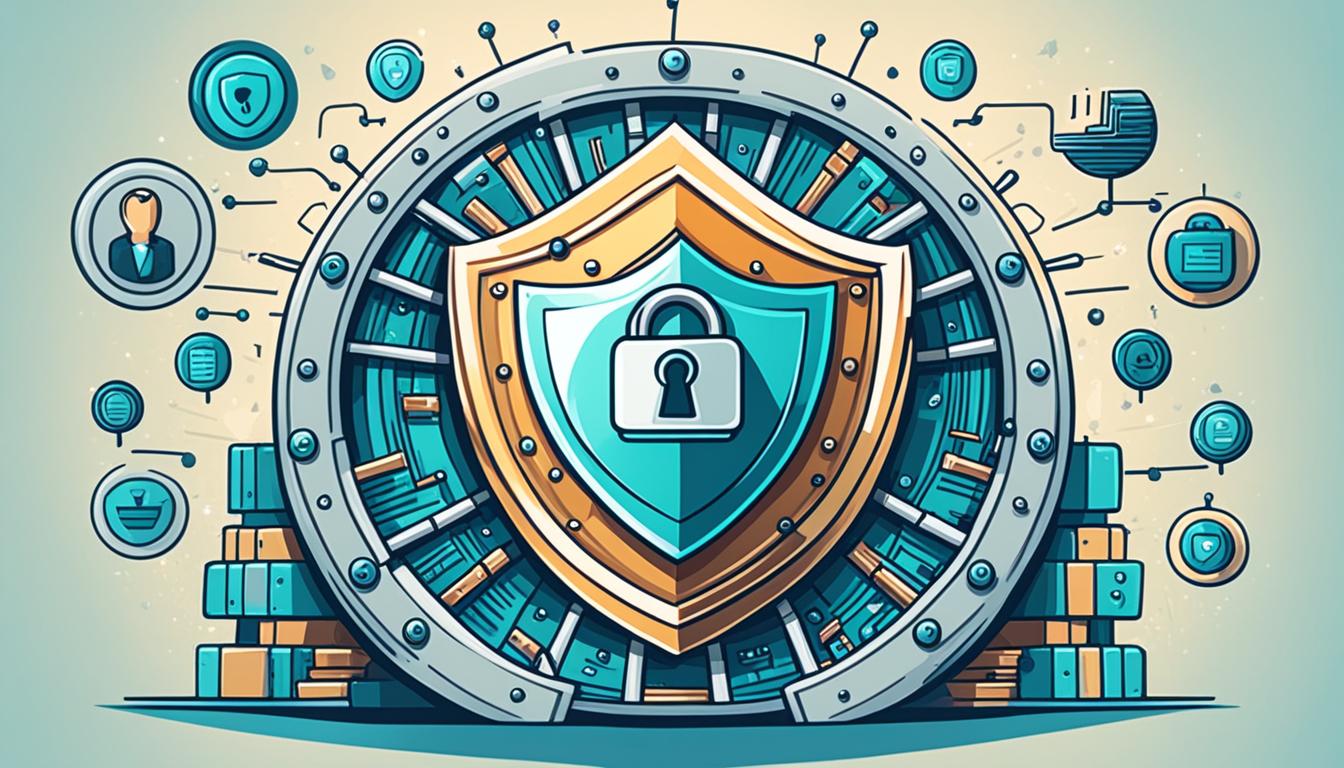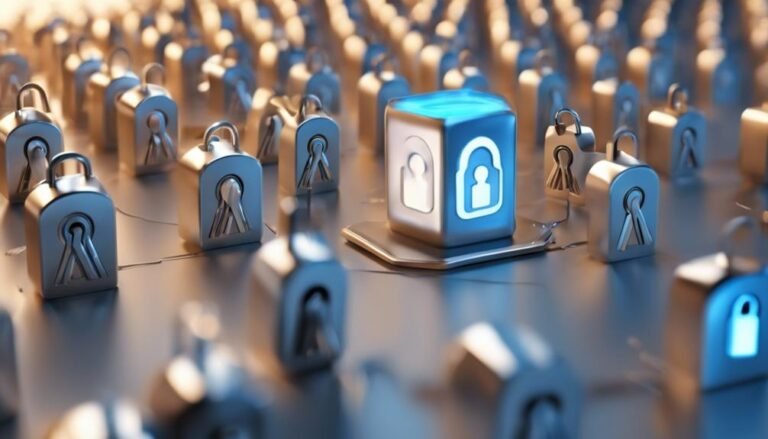AI and Cybersecurity: Protecting Business Data
Our digital world is growing fast, with artificial intelligence (AI) playing a bigger role each day. While AI offers amazing benefits, there’s a worry about keeping critical data safe. How can companies protect their important information from digital threats that keep getting more advanced?
Old-fashioned cybersecurity methods can’t always cope with new challenges. It’s clear we need to get ahead of threats. AI is leading the charge by spotting and stopping attacks fast, predicting future problems, and analyzing how we act online. Now, adopting AI is a critical move for businesses to keep their data safe.
Key Takeaways:
- AI is revolutionizing cybersecurity by enhancing threat detection and prevention capabilities.
- Businesses must adopt AI as a proactive strategy to protect their valuable data.
- Addressing data privacy concerns is crucial when integrating AI into cybersecurity practices.
- The global community is actively working on standardized AI practices and regulations.
- Cybercriminals are also leveraging AI technology to carry out sophisticated cyberattacks.
The Role of AI in Cybersecurity
AI is changing how we deal with cyber threats. It provides powerful tools to find and stop these dangers. As cyber attacks get more complex, we need AI to keep up. It helps make our defense stronger and keeps us safe from new threats.
Enhanced Threat Detection and Analysis
AI checks a lot of network traffic to spot unusual patterns that could mean trouble. It uses its learning to quickly find things that seem off. This includes looking for malware. It makes finding and fighting off threats better than before.
Automated Threat Monitoring
AI is great at watching for threats all the time. It takes in data from many places to stay on top of new dangers. This means businesses can stop attacks before they do much harm.
Predictive Risk Assessment
AI looks at old data to guess how likely future attacks are. By using these guesses, companies can focus on what’s most important. This way, they use their resources and plans smartly to keep threats low.
Identifying and Mitigating Social Engineering and Password Hacking Risks
Cybercriminals use tricks like social engineering and hacking passwords a lot. AI can catch these tricks by watching how people act online. It alerts companies to weird activities, helping keep data safe.
Improved Incident Response
AI speeds up how we deal with attacks by handling parts of the work itself. It looks at what’s going on, advises people, and helps decide what to do next. With AI’s help, groups can react faster and limit attack damage.
| AI in Cybersecurity Benefits | Example |
|---|---|
| Faster threat detection | AI algorithms can detect and respond to threats in real-time, minimizing the time window for potential damage. |
| Improved accuracy | AI-powered systems can analyze large volumes of data with high accuracy, reducing false positives and negatives. |
| Efficient resource allocation | AI helps prioritize cybersecurity efforts by identifying high-risk areas and allocating resources accordingly. |
| Continuous monitoring | AI can provide round-the-clock monitoring of network activities, detecting threats even outside regular working hours. |
| Adaptive defense strategies | AI can adapt to evolving cyber threats and modify defense strategies accordingly, staying one step ahead of attackers. |
With cyber threats always changing, AI’s role in security will keep growing. Using AI, companies can make their defenses stronger. They can protect data and watch out for new threats effectively.
Addressing Data Privacy Concerns with AI
AI and cybersecurity are key in defending business data, but we must also focus on data privacy. Through transfer learning, AI improves using knowledge from one task for another, preserving privacy. The concept of Privacy by Design ensures privacy is secure right from the start in AI projects.
Focusing on privacy by design helps companies use AI safely, balancing benefits with protecting privacy. This method reduces privacy risks, builds client trust, and ensures compliance.
“AI’s potential to revolutionize cybersecurity must go hand in hand with the protection of individuals’ privacy rights.”
Privacy-focused AI helps companies improve cybersecurity without infringing on privacy. They should use frameworks that emphasize preventing data breaches with AI and keeping privacy paramount in AI development.
The Principles of Privacy by Design
To effectively deal with data privacy concerns, organizations should follow these Privacy by Design principles:
- Privacy considerations must be built into AI solutions from the start, not added later.
- Organizations should make privacy the default setting, ensuring it’s always protected.
- Privacy should be a core part of AI design and architecture.
- Privacy features should enhance the benefits of AI, not limit them.
- Ensure data privacy from the start to the finish of AI system use.
- Make data use and privacy rules clear to everyone.
- Focus on what’s best for individuals when handling privacy concerns.
Privacy by Design and AI Implementation
Privacy by Design links closely with AI implementation, addressing privacy risks. When privacy is a central part of AI, companies win customer trust. They also show they’re serious about ethical data use.
AI solutions for stopping data breaches are critical in keeping sensitive info safe. These tools use AI to find and fix security holes, better respond to incidents, and stop data breaches.
Companies need to opt for AI solutions that put data privacy and security first. This helps protect sensitive info, follow privacy laws, and improve their cybersecurity stance.
A Holistic Approach to Data Privacy and Cybersecurity
Tackling data privacy with AI demands a constant effort. Organizations should regularly check and tweak their AI use to keep privacy a top concern.
Through promoting privacy and cybersecurity as key values, companies can better educate workers. This ensures the right handling of data and policy setup. Routine checks can find any privacy risks and keep AI use within privacy norms.
A complete privacy and cybersecurity strategy, backed by AI, helps businesses defend against digital threats. It also protects privacy effectively.
The Global Landscape of AI and Cybersecurity
The world of AI and cybersecurity is always changing. This is because many groups are working together to ensure data safety and privacy. They do this to fight against more and more cyber attacks and to safely use new AI techs.
One big group working on AI is the Global Partnership for Artificial Intelligence (GPAI). It consists of major countries aiming to better AI’s use. They set standards and guidelines for the world. This way, they help to improve AI everywhere and encourage new ideas.
The QUAD is also important. It includes the US, India, Japan, and Australia. These countries team up to tackle security issues and work together on AI. They share their knowledge and support rules that help control AI use worldwide.
Countries and organizations create rules too. For example, the European Union made the AI Act to protect data when using AI. This act asks for clear and fair AI use. It is a guide for others to make their own data protection rules.
The world is working hard to make AI and cybersecurity safe for all. With rules and working together, we aim to use AI responsibly and keep people’s data secure.
AI Ethics Agreement
It’s vital to agree on how to ethically use AI. Organizations are making agreements to use AI in good ways. These deals focus on respecting privacy, being fair, and accountable.
These groups show a global promise to use AI the right way. They look to gain AI’s benefits without forgetting the possible harm it might cause.
Regulatory Sandboxes
Regulatory sandboxes are key in the AI world. They let new AI doings be tested in safe setups. This helps companies follow rules while trying new things.
By giving a place to innovate, these sandboxes make new AI possible. They also help policymakers make rules that make sense with the latest tech. This keeps our tech safe as it grows.
| Partnership/Initiative | Objective |
|---|---|
| Global Partnership for Artificial Intelligence (GPAI) | Advance responsible AI development and use through international collaboration and standard-setting |
| Quadrilateral Security Dialogues (QUAD) | Address regional security challenges and explore opportunities for cooperation, including in AI |
| European Union’s AI Act | Ensure data privacy and security in AI development through regulations and ethical standards |
Many groups are working hard together to ensure good and safe AI use. They create rules and special places to test new AI. This way, we are making sure AI grows responsibly and safely.
The Impact of AI on Cyberattacks
In today’s world, AI is changing how we protect our digital spaces. It’s also giving cybercriminals new powers. They can now automate scams, make better password hackers, create deepfake videos, and trick AI systems. As a result, businesses and groups worldwide must use AI to defend against these new threats.
An example is how AI is making phishing attacks more real. Cybercriminals send emails and messages designed to look authentic, fooling many. This misuse of AI can lead to more successful attacks, putting user data at risk.
AI is also making it easier for criminals to crack passwords. By looking at lots of leaked password data, AI can guess passwords better. This allows hackers to break through common security measures and access important data.
AI technology is not only being used for cybersecurity but also by cybercriminals to carry out sophisticated attacks.
Deepfakes are a new big worry. They’re fake but realistic videos or images created with AI. Cybercriminals can use these to deceive people, spread lies, or harm others’ reputations.
There’s also the danger of AI-based data fake-outs. Injecting bad data into AI systems can mess up cyber defenses. This can make systems either miss real threats or wrongly alert to fake ones. It’s a sneaky but dangerous tactic.
AI is even helping create advanced malware. This malware is smart, adjusting its actions to avoid getting caught. It can bypass normal security methods, stay hidden in systems, and steal data without detection.
To fight back, businesses need to use AI in their cybersecurity. AI can help detect and stop these AI-driven attacks. With the right AI tools, threats can be found and dealt with before they cause harm.
The Need for AI-Powered Cybersecurity
Cybercriminals with AI can outsmart old security measures. This is where AI-powered defenses are invaluable. They watch for unusual activities, pinpoint threats, and stop them before damage is done.
AI also enhances how organizations handle cyber incidents. It can quickly look into issues, provide intel, and help make smart security decisions. This speeds up response, uses resources better, and lessens the harm from attacks.
AI has changed the game in cybersecurity. While it has brought new risks, it also offers powerful ways to keep our digital world safe. Businesses using AI in their defenses can get ahead of cyber threats and protect what matters most.
Statistics on the Cost of Cybersecurity Breaches
Keeping your business data safe from cyber threats is key. But it’s also about the money. A data breach can cost a business millions of dollars on average. It’s vital to know these costs and work to stop them.
Using AI for security has led to big savings for some companies. Artificial intelligence can spot and stop cyber attacks better. This lowers the cost of dealing with breaches.
The expense of cybercrime keeps going up. It could even hit trillions of dollars soon. This huge number shows why using AI in cybersecurity is a must. It’s about protecting data and money.
AI can make a business’s defenses stronger and cut the losses from a breach. With AI, threats can be found and handled before they do big harm. This saves time and money.
By using AI, businesses can outsmart fast-changing cyber dangers. AI helps keep data safe and cuts down on the financial fallout of breaches. It strengthens a company’s ability to fight off cyber attacks and keep earning.
Key Statistics:
– The average cost of a data breach is estimated to be millions of dollars.
– Companies utilizing AI-powered cybersecurity solutions report significant cost savings.
– The cost of cybercrime is expected to reach trillions of dollars in the coming years.
How AI Benefits Cybersecurity
AI brings many benefits to cybersecurity. It uses advanced algorithms and machine learning. This makes security measures better and faster, helping businesses protect their data.
AI is quicker at spotting cyber threats than people. It can pick out risky emails and messages to stop phishing. Also, by mimicking social engineering, AI shows where a company’s defenses are weak.
AI is great at sifting through loads of data from security incidents. It can catch on to any odd patterns early. This means it can warn about threats before they do big harm.
AI doesn’t just spot threats early. It can also guess where a data breach might happen. Looking at past incidents helps it find weak spots. This lets businesses act before a breach occurs.
If a breach does happen, AI is quick to help. It digs into real-time data to give actionable advice. This speeds up response times and lessens the damage from attacks.
AI also shines in spotting fraud. It looks at data like user behavior to find fraud patterns. This helps businesses stop fraud and save money.
To wrap up, AI boosts cybersecurity with better fraud and threat detection. By using AI, companies can protect their data more effectively.
AI in Network Security
Protecting business data online is more important than ever. Cyber threats are growing more complex. Organizations need to use artificial intelligence (AI) to improve their defense. AI helps by quickly sorting through network data and spotting any unusual or dangerous activity.
AI is highly effective in spotting when someone shouldn’t be on your network. It watches network traffic closely. By spotting strange login patterns and unauthorized access, AI can stop a potential cyberattack before it does any harm.
When it comes to finding viruses and other malware, AI is a game-changer. Traditional methods can’t keep up with the new malware that’s always evolving. But AI can sift through large amounts of data to find these harmful programs, even if they’ve been designed to avoid detection.
AI gives companies a better grip on their network security. It provides deep insights and takes action to stop cyber threats. This helps businesses improve their defenses and respond to attacks faster, reducing any damage done.
The Benefits of AI in Network Security
AI-powered security brings several important advantages:
- Efficient Threat Detection: AI quickly looks through lots of data to find hidden threats that usual methods might miss.
- Real-Time Response: With AI, systems can react the moment a threat is identified, making attacks less damaging.
- Continuous Monitoring: AI doesn’t stop watching your network, meaning it can catch threats as they evolve, in even the most complicated setups.
- Improved Accuracy: AI gets better at its job the more it sees, making it better at finding and stopping new threats.
By using AI for security, companies can protect their data and networks from the latest cyber threats.
AI in Network Security: A Comparative Analysis
| Traditional Network Security | AI-Powered Network Security |
|---|---|
| Relies on predefined rules and signatures. | Utilizes machine learning algorithms to detect anomalies and unknown threats. |
| May miss emerging threats without regular updates. | Can adapt and learn from new attack vectors to detect evolving threats. |
| Response times may be slower due to manual analysis. | Enables real-time response through automated threat detection and incident response. |
| Requires manual configuration and maintenance. | Uses self-learning algorithms to adapt to changing network environments. |
| Limited scalability for large and complex networks. | Can scale to analyze vast amounts of network traffic across extensive infrastructures. |
The table compares traditional and AI-focused network security. AI’s learning and fast reaction times give it a clear edge, helping organizations stay ahead of threats.
AI for Data Breach Prevention
AI is changing cybersecurity, giving companies better ways to stop data breaches. It lets businesses guard their important data ahead of time. This cuts the chance of being hit by cyber dangers. AI is key in keeping data breaches at bay.
Identifying Vulnerabilities
AI checks IT assets for spots that hackers could use. It looks at networks and software with smart algorithms. By spotting these weak links, companies can beef up their security.
Detecting and Analyzing Threats
AI watches for signs of an attack, always on the lookout. It might see strange data moves or details about someone trying to break in. Catching these and spotting weird behavior mean early warnings for businesses, helping avoid data leaks.
Risk Sensing and Prediction
AI can guess the odds and impact of a data breach. It does this by looking at past cases and their risks. With this info, it’s better at choosing what security steps to take first. This way, companies can protect their most critical parts first.
Identifying and Mitigating Bad Bots
Bad bots are the tools bad actors use to do harm, like hacking into accounts. AI is good at seeing these bots by how they act and stopping their damage. This adds a strong layer of defense against data breaches.
AI for Fraud Detection
AI is very good at finding and stopping fraud. It uses advanced algorithms and pattern recognition. This helps businesses keep their money safe.
One big strength of AI in fraud is seeing patterns in lots of data sources. It checks large amounts of data to see fraud signs. This way, it catches fraud early, saving money and problems.
Pattern spotting is key in AI’s fraud work. AI can find strange patterns that might mean fraud. By learning from new data, AI is always ready for new fraud tricks.
“By leveraging advanced AI algorithms and pattern recognition, businesses can strengthen their fraud detection capabilities and protect their financial interests.”
Many industries are using AI to fight fraud. Banks find unauthorized payments and money laundering with AI. Online shops stop fake orders and fraud accounts.
Benefits of AI in Fraud Detection:
- AI is swift and precise in examining loads of data, making fraud spotting better.
- Systems powered by AI catch fraud as it happens, cutting down on losses.
- By cutting down fake alarms, AI ensures it spots real fraud accurately.
- AI keeps learning to fight new types of fraud, always staying updated.
Using AI helps businesses guard their money and customer trust better. AI quickly spots and stops fraud, giving companies an edge over fraudsters.
AI for Incident Response
Keeping up with strong cybersecurity is key. With cyber attacks getting more complex and frequent, swift response is crucial. AI changes the game by making responses faster and better.
AI boosts how security teams handle incidents. It makes finding and stopping threats faster and more accurate. Using AI tech cuts down on time and resources needed.
“AI automation greatly enhances incident response capabilities, enabling security teams to respond faster and with greater accuracy.”
AI looks at data from many sources and finds ways to act. It spots unusual patterns or signs of attacks. This allows teams to react where it matters most.
AI also keeps an eye on threats all the time. It spots weak spots and catches risky behavior, starting a quick response.
Plus, it helps formulate what to do next using set rules and learning from past solutions. Making choices this way is smarter and quicker, cutting out human mistakes.
Benefits of AI for Incident Response
1. AI quickly finds and checks threats, making response times faster.
2. It can sift through large amounts of data to find hidden signs of trouble accurately.
3. AI handles many parts of the response, letting humans focus on important plans and strategies.
4. AI systems can handle many incidents at once, spreading resources well.
5. It watches for threats round the clock, protecting data and systems without stopping.
Conclusion
AI is changing how we keep our data safe from cyber threats. It gives businesses strong tools to fight off attacks. By using AI, these companies can detect and stop cyber attacks before they do harm.
But, keeping people’s data private is very important. Businesses need to make sure that using AI follows privacy rules. They should use the right plans and AI tools to protect people’s personal data and earn their trust.
AI is crucial for protecting business data as the digital world changes. To keep their data safe, companies need to keep learning about AI and how it fights cyber threats. Using AI in cybersecurity is now a must for any organization wanting to keep their business secure online.







